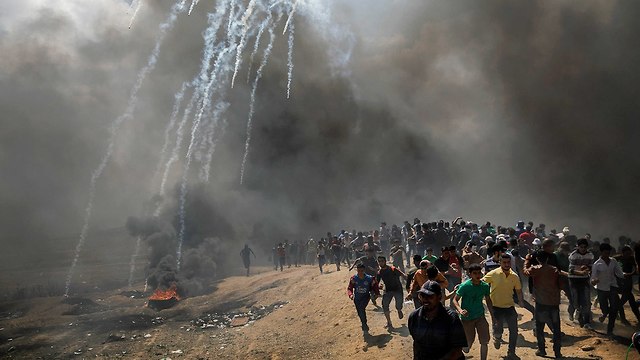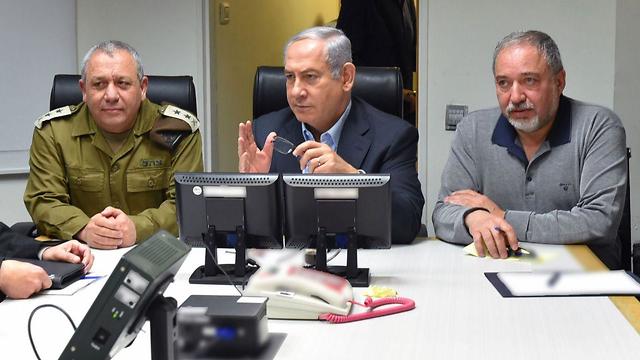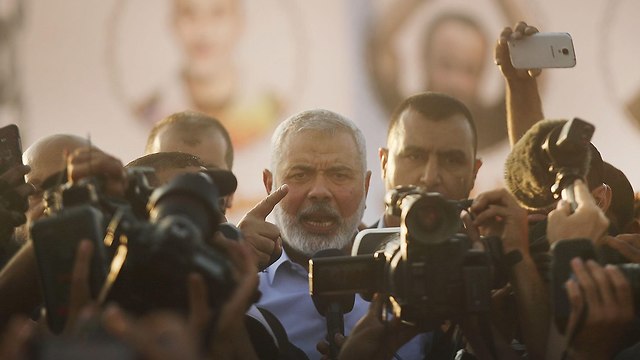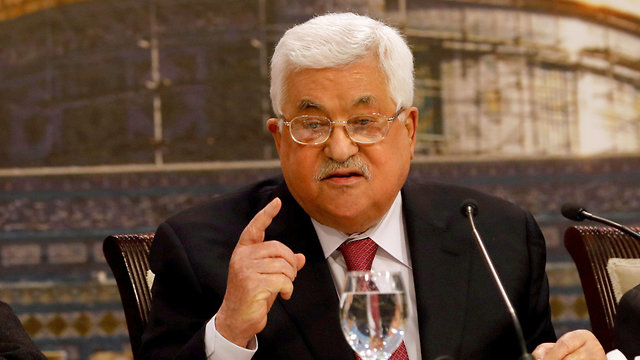
There is a way to solve the Gaza crisis
Analysis: An arrangement led by Egypt and supervised by UN and Arab League inspectors, which would lead to the creation of a joint PA-Hamas civil government, would serve all parties and gradually dismantle the explosive conflict—even without forcing Hamas to disarm completely. While this solution may be far from ideal for Israel, the chance is worth the risk.
This may be another battle which will end in the exact situation we have today or an even worse one. In such a situation, Hamas won’t be there and we’ll have to deal with a governmental anarchy in the strip that is bound to spill into our territory.
When that happens, we will have no other choice but to return as an occupying force that will have to take care of the needs of two million hostile Palestinians. Security officials in Israel share the opinion that we have no interest in toppling the Hamas rule at this time, as it would lead to the creation of a governmental void in the strip.
The defense establishment is interested in stopping the deterioration down this slippery slope through a quick implementation of a comprehensive plan for humanitarian and economic aid to the strip. This recommendation from the IDF—and recently from the Shin Bet as well—is based on a simple idea: Humanitarian welfare (water, sewage, health and electricity services) and economic development (reducing unemployment) will calm things down among the population and prevent incitement and use of the population as human ammunition and shields by Hamas.
The Palestinians in the West Bank aren’t rushing to join the clashes with the Israeli security forces, mainly because of the reasonable—or at least tolerable—economic and governmental situation there. A lull and an improvement in the population’s situation, which will require cooperation with the Palestinian Authority and with Egypt, will also help remove Hamas from its complete isolation and alleviate its fears for the survival of its government.
Such a plan basically exists on paper and has already been discussed in Washington as part of a conference of the Arab and European donor states, Israel, the Palestinian Authority, Egypt and of course the American administration. The conference was presented with a plan that would lead to welfare and calm in the strip, whose initiator and proponent was Major-General Yoav Mordechai, the coordinator of the government’s activities in the territories up until a few weeks ago.
This plan includes everything it takes to rescue the Gazans and Hamas from their distress: Building factories for water desalination and purification, a high-voltage line for electricity supply and a long list of civilian economic projects. It also includes a general agreement on an outline and distribution of the burden required to fund this excellent plan. Its implementation could dramatically improve the economic and humanitarian situation in the strip, thereby reducing the threat of a deterioration to violence.
Why not?
The main obstacle in implementing this plan is the lack of a functioning civilian government in the Gaza Strip that would be able to implement it on the ground. Another obstacle is the lack of a calm and the continuation of exchanges of fire with Israel, which are threatening to destroy the infrastructure and economic projects, as has often happened in the past.
The internal Palestinian reconciliation, which was initiated by Egypt with Hamas’ consent, was supposed to solve these two obstacles. The Palestinian Authority led by Mahmoud Abbas was supposed to enter the strip as a civilian government body and oversee the reconstruction instead of Hamas, which failed to do so. But despite the Egyptian efforts and the agreement that was signed, the internal Palestinian reconciliation failed. The reason was Hamas’ refusal to disarm, as both Abbas and Israel had demanded.
Israel presented the equation “reconstruction for demilitarization” as a condition for participating in the strip’s humanitarian-economic rescue plan, and Abbas demanded that Hamas disarm and subordinate its military arm to the civilian government. Hamas refused, and Abbas suspended the transfer of funds to the civilian government in the strip, intentionally worsening the civilians’ distress without any hesitations and increasing their willingness to commit suicide on the fence.
But the humanitarian, economic and government dead end in the Gaza Strip at the moment isn’t a predetermined outcome. We can reach a calm in the strip that will make it possible to implement the humanitarian and economic Marshall Plan. I’m not referring to the “hudna” with Israel, which some Hamas leaders proposed to the Egyptian intelligence chief half-heartedly. Such a “hudna” would allow Hamas to enjoy an improvement in the population’s situation thanks to Israel, build its military strength and then renew the fighting. A “hudna” contradicts Israel’s long-term security interest, which is why Jerusalem is rightly opposed to this dangerous idea.
So what can be done?
There is another outline for an arrangement that has already been successfully tried out in recent years in several areas of a violent conflict and humanitarian crises around the world. This outline is based on a permanent arrangement performed in stages—a military and political compromise under the auspices of an international mandate and power, which would provide legitimization and legal validity. The arrangement will serve all parties and make it possible to gradually dismantle the explosive conflict.
I have seen for myself such arrangements, in Liberia and then in Kosovo, lead to a partial lull at first and then pave the way to a long-term solution of the conflicts. They weren’t a howling success, and it took time before they were able to overcome all the obstacles and violations of the agreements that sabotaged them. But at the end of the day, they led to a long-term and stable lull—and that’s exactly what we need in Gaza now.
It’s important to add at this point that the principles of the arrangement, which will be specified shortly, have been the subject of discussions and brainstorming in the defense establishment and perhaps also in the National Security Council at the Prime Minister’s Office. These are initial ideas which have not been fully developed yet, but they have already been placed on the table not only in Israel but in several capitals in the region as well.
The main idea is that it’s possible to reach an arrangement that will be based on a compromise and on international support, even without forcing Hamas to disarm completely. The timing seems suitable. We must take advantage of the state of shock in Hamas and the other Palestinian organizations following last week’s bloody clashes on the fence, as well as the shock in the international, Arab and Israeli arena, to reach an agreement. Hamas will have an interest in such an arrangement too, which will help it out of the dead end it has gotten itself into, which is threatening the survival of its government in the strip.
An arrangement under international and regional auspices could succeed in solving the Gazan problem if it is based on the following principles:
- The arrangement will be led by an Arab-Muslim element—preferably Egypt—and will be based on resolutions of the United Nations Security Council and of the Arab League, which will provide it with legitimation and legal validity.
- The goal of the arrangement is an immediate fundamental improvement in the Gazan population’s humanitarian and economic situation and a preparation for general democratic and secret elections for a government in the strip, which will be held under the auspices and supervision of the UN a year or two later. These elections will reflect the Gazans’ will, and there is a good chance that the elected government will have a strong interest in continuing the calm and political stability that will pave the way for economic welfare and development.
- The arrangement will be enforced on the ground by teams of observers and inspectors sent by the UN and a peacekeeping force send by the Arab League and Turkey.
- As a first step, Hamas and the PA will implement their reconciliation agreement and establish a joint civil government in the strip. For that purpose, they will reach a compromise on controlling the military force: Hamas will disarm from its heavy weapons and offensive infrastructure, but the members of its military wing and of Islamic Jihad will be permitted to keep their personal weapons and small arms. The heavy weapons—the heavy mortar shells, the rockets and antitank missiles and the unmanned aerial vehicles—will be handed over to the UN inspectors, who will remove them from the strip.
- Members of Hamas’ military wing, with their small arms, will be incorporated into the civilian government’s law enforcement forces in the strip, which will be shared by Hamas and the PA. Hamas will pledge to avoid developing and arming itself with rockets, missiles and heavy weapons as long as the arrangement remains in effect, and will avoid digging attack tunnels as well. The organization will provide the UN with the location of the tunnels and destroy them under UN supervision. The Arab-Muslim peacekeeping force and UN observation posts will be deployed west of the fence and of the border obstacle between Gaza and Israel and will ensure that no offensive activity takes place against western Negev communities from that area.
- Egypt will open the Rafah Crossing and other crossings almost unlimitedly but under strict supervision, to prevent the smuggling of weapons and terrorists into the strip or from the strip to Sinai. Israel will contribute to the agreement’s implementation by opening all the border crossings, under tight security supervision, and will provide its approval for the establishment of a seaport off the shores of Gaza, which will be managed under European security supervision with the participation of professionals from the Gulf states. Israel will remain responsible for the maritime area north and west of the strip, and Egypt will supervise the maritime area opposite its sovereign territory in Sinai.
Problems and solutions
As far as Israel is concerned, this arrangement is far from ideal. There is a danger that Hamas and Islamic Jihad, with Iran’s help, will secretly build their strength while deceiving the UN inspectors and bribing members of the Arab-Muslim force.
Another difficulty will arise if the rejectionist organizations fire into the State of Israel. The IDF will find it difficult to retaliate in a deterring manner as it does today, for fear of hitting UN members and soldiers of the multinational force inside the strip. A ground invasion of Gaza will be more difficult too if necessary. It will be hard to implement, but it’s definitely possible militarily and politically.

In any event, the chance is worth the risk. It’s important to stress that the Shin Bet and the IDF’s intelligence will keep supervising the situation in the strip and providing UN inspectors with information that will help them handle the different violations of the arrangement, including tunnel digging.
Moreover, the defense establishment is expected to complete the construction of the obstacle under and above the ground on the Gaza Strip border within less than a year, and that will reduce the risk of direct fire from the strip into Israel and infiltrations of Gazans into our territory.
Another difficult problem, as far as the current Israeli government is concerned, is that an internationally-backed arrangement for Gaza creates a precedent concerning the West Bank. The Palestinians (Abbas or his successors) could demand the implementation of such an agreement on all the lands occupied in 1967 without reaching an agreement with Israel first. Such a demand would serve as an obstacle to serious peace negotiations based on a compromise between Israel and the Palestinians.
An internationally-backed arrangement of the situation in Gaza has many other shortcomings, but at the moment it’s the only real possibility of reaching a calm and stability soon, as far as all parties are concerned. Such an arrangement will lead to humanitarian aid and economic projects that will rescue the population from its despairing distress.
It will also serve Hamas and perhaps allow democratic elections that will lead to a stable political government in the strip. Without an international and Arab-Muslim framework (including Qatar and Turkey), it will be impossible to reach a long-term lull, fund humanitarian aid and economic development and get out of the bloody dead end we have reached.
Israel must take advantage of its good relations with the Trump administration, with Egypt and with Jordan, and it’s not-as-good relations with the Europeans and Gulf states, and work behind the scene to enlist everyone for a quick creation and implantation of a military, economic and political arrangement for the Gaza Strip.




















